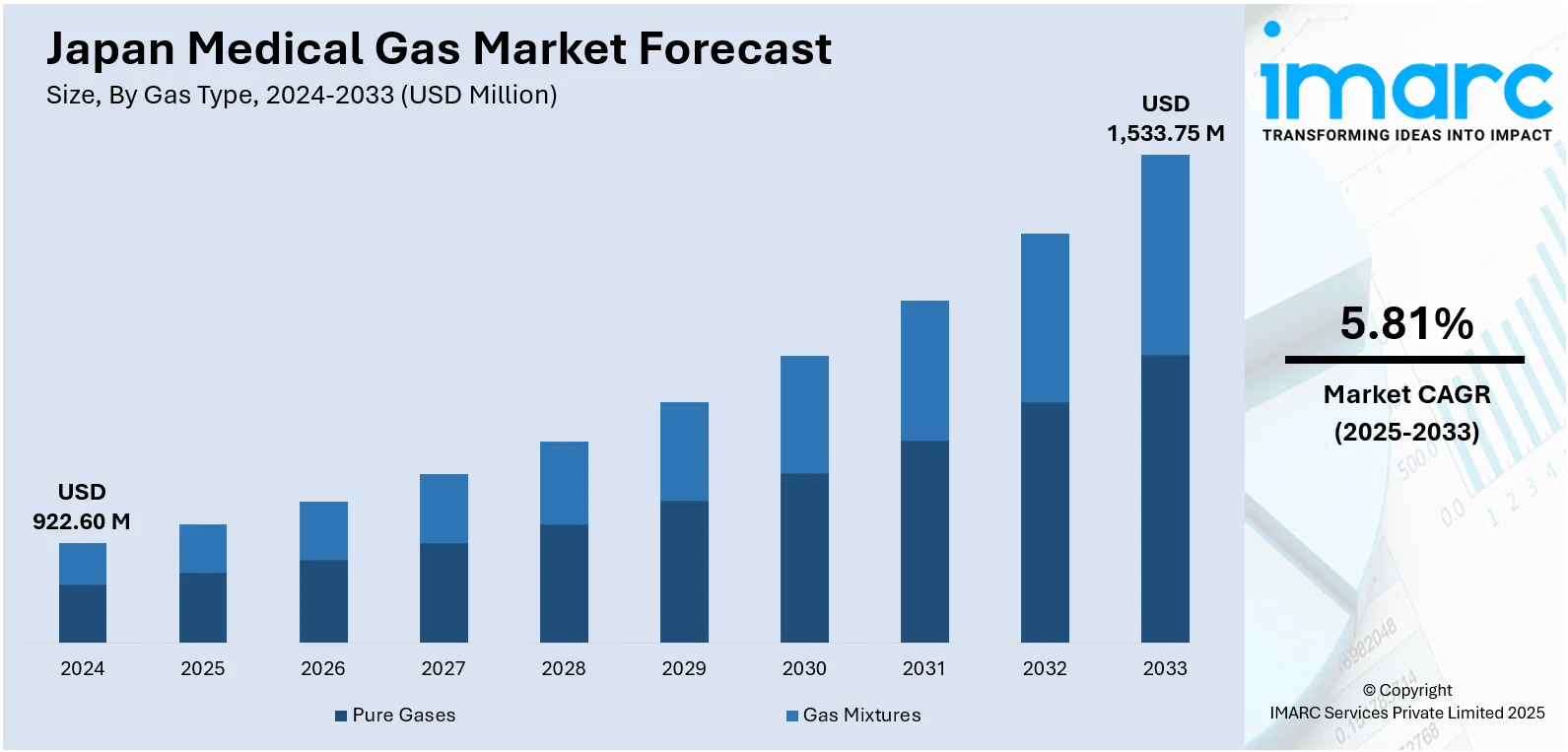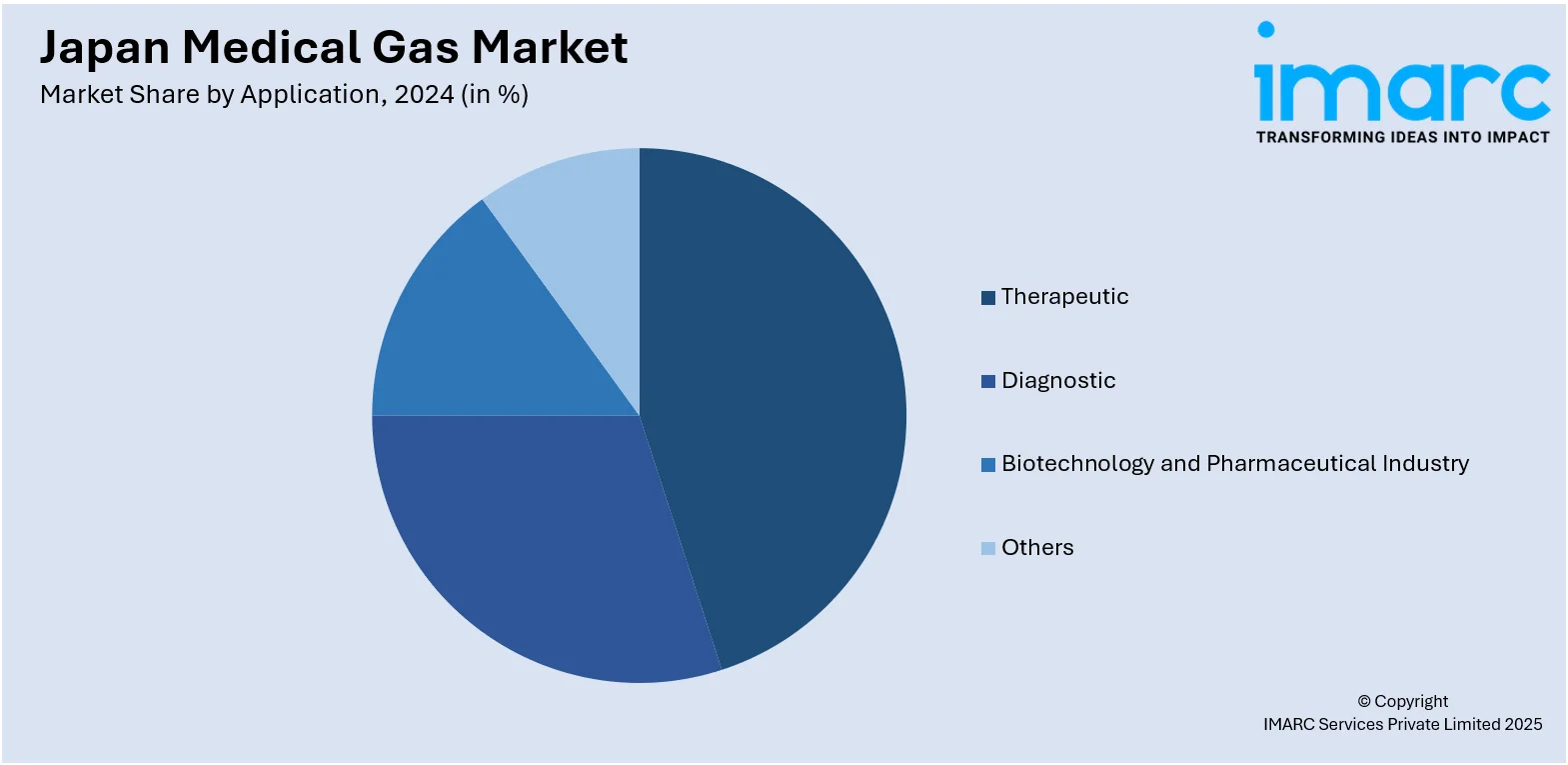
Japan Medical Gas Market Size, Share, Trends and Forecast by Gas Type, Application, End User, and Region, 2025-2033
Japan Medical Gas Market Overview:
The Japan medical gas market size reached USD 922.60 Million in 2024. Looking forward, IMARC Group expects the market to reach USD 1,533.75 Million by 2033, exhibiting a growth rate (CAGR) of 5.81% during 2025-2033. The market is witnessing steady growth, driven by increased demand for advanced healthcare services, rising surgical procedures, and an aging population. Hospitals and home healthcare providers are increasingly utilizing medical gases for respiratory support, anesthesia, and diagnostics. Ongoing healthcare infrastructure development and advancements in gas delivery systems also contribute to market expansion. Key industry players are enhancing product offerings to maintain their competitive edge in the Japan medical gas market share.
|
Report Attribute
|
Key Statistics
|
|---|---|
|
Base Year
|
2024
|
|
Forecast Years
|
2025-2033
|
|
Historical Years
|
2019-2024
|
| Market Size in 2024 | USD 922.60 Million |
| Market Forecast in 2033 | USD 1,533.75 Million |
| Market Growth Rate 2025-2033 | 5.81% |
Japan Medical Gas Market Trends:
Aging Population Impact
Japan's fast-aging population is having a substantial impact on the market's growth. Being one of the world's countries with the highest percentage of elderly population the need for long-term healthcare services is increasing. According to industry reports, Japan's geriatric population has reached an all-time high of 36.25 million, with individuals aged 65 and older representing 29.3% of the overall population. Of this group, around 20.53 million are women and 15.72 million are men. The elderly are more susceptible to chronic respiratory diseases, cardiovascular diseases, and other age-related conditions that tend to necessitate constant use of medical gases like oxygen and nitrous oxide. The higher number of nursing homes, assisted living facilities, and home care services is also increasing the demand for dependable medical gas supply systems. Additionally, the elderly population is also driving the increase in the number of surgeries and post-operative care that require anesthesia and other therapeutic gases. This population trend is likely to continue as a leading market driver forcing healthcare providers and suppliers to enhance infrastructure and the availability of sophisticated gas solutions.

To get more information on this market, Request Sample
Expansion of Home Healthcare Services
The increasing demand for home-based medical treatment in Japan is considerably increasing the demand for portable medical gas equipment. The need for customized care, reduced hospitalization expenses, and increased patient quality of life are some of the reasons driving this trend. Patients suffering from long-term respiratory ailments, the elderly with oxygen therapy, and post-surgery recovery patients mostly prefer home healthcare services. Therefore, the demand for portable, safe, and convenient gas delivery systems such as portable oxygen concentrators and cylinders is increasing. This trend not only aids patient convenience and comfort but also lightens the load of hospitals generating good growth opportunities for suppliers and manufacturers in the Japan medical gas market.
Growing Focus on Safety and Compliance
Strict regulatory frameworks governing the purity, storage, and handling of medical gases are playing a vital role in shaping the Japan medical gas market growth. Authorities demand adherence to high safety standards to ensure patient well-being and avoid contamination or misuse of gases like oxygen, nitrous oxide, and carbon dioxide. As a result, manufacturers are investing in advanced packaging technologies, tamper-proof containers, and real-time monitoring systems to maintain compliance. Innovations such as smart cylinders with digital gauges and automated leak detection systems are becoming more prevalent. These advancements not only enhance safety and traceability but also build trust among healthcare providers thereby supporting the wider adoption of medical gas systems and contributing to sustained market expansion.
Japan Medical Gas Market Segmentation:
IMARC Group provides an analysis of the key trends in each segment of the market, along with forecasts at the country and regional levels for 2025-2033. Our report has categorized the market based on gas type, application, and end user.
Gas Type Insights:
- Pure Gases
- Medical Air
- Medical Oxygen
- Nitrous Oxide
- Nitrogen
- Carbon Dioxide
- Helium
- Gas Mixtures
- Aerobic Gas Mixtures
- Anaerobic Gas Mixtures
- Blood Gas Mixtures
- Lung Diffusion Mixtures
- Medical Laser Mixtures
- Medical Drug Gas Mixtures
- Others
The report has provided a detailed breakup and analysis of the market based on the gas type. This includes pure gases (medical air, medical oxygen, nitrous oxide, nitrogen, carbon dioxide, and helium) and gas mixtures (aerobic gas mixtures, anaerobic gas mixtures, blood gas mixtures, lung diffusion mixtures, medical laser mixtures, medical drug gas mixtures, and others).
Application Insights:

- Therapeutic
- Diagnostic
- Biotechnology and Pharmaceutical Industry
- Others
A detailed breakup and analysis of the market based on the application have also been provided in the report. This includes therapeutic, diagnostic, biotechnology and pharmaceutical industry, and others.
End User Insights:
- Hospitals
- Home Healthcare
- Academic and Research Institutions
A detailed breakup and analysis of the market based on the end user have also been provided in the report. This includes hospitals, home healthcare, and academic and research institutions.
Regional Insights:
- Kanto Region
- Kansai/Kinki Region
- Central/Chubu Region
- Kyushu-Okinawa Region
- Tohoku Region
- Chugoku Region
- Hokkaido Region
- Shikoku Region
The report has also provided a comprehensive analysis of all the major regional markets, which include Kanto Region, Kansai/Kinki Region, Central/Chubu Region, Kyushu-Okinawa Region, Tohoku Region, Chugoku Region, Hokkaido Region, and Shikoku Region.
Competitive Landscape:
The market research report has also provided a comprehensive analysis of the competitive landscape. Competitive analysis such as market structure, key player positioning, top winning strategies, competitive dashboard, and company evaluation quadrant has been covered in the report. Also, detailed profiles of all major companies have been provided.
Japan Medical Gas Market News:
- In December 2023, the National Cerebral and Cardiovascular Center issued a procurement notice seeking suppliers for medical gas. The delivery period for this contract will run from April 1, 2024, to March 31, 2026.
Japan Medical Gas Market Report Coverage:
| Report Features | Details |
|---|---|
| Base Year of the Analysis | 2024 |
| Historical Period | 2019-2024 |
| Forecast Period | 2025-2033 |
| Units | Million USD |
| Scope of the Report |
Exploration of Historical Trends and Market Outlook, Industry Catalysts and Challenges, Segment-Wise Historical and Future Market Assessment:
|
| Gas Types Covered |
|
| Applications Covered | Therapeutic, Diagnostic, Biotechnology and Pharmaceutical Industry, Others |
| End Users Covered | Hospitals, Home Healthcare, Academic and Research Institutions |
| Regions Covered | Kanto Region, Kansai/Kinki Region, Central/Chubu Region, Kyushu-Okinawa Region, Tohoku Region, Chugoku Region, Hokkaido Region, Shikoku Region |
| Customization Scope | 10% Free Customization |
| Post-Sale Analyst Support | 10-12 Weeks |
| Delivery Format | PDF and Excel through Email (We can also provide the editable version of the report in PPT/Word format on special request) |
Key Questions Answered in This Report:
- How has the Japan medical gas market performed so far and how will it perform in the coming years?
- What is the breakup of the Japan medical gas market on the basis of gas type?
- What is the breakup of the Japan medical gas market on the basis of application?
- What is the breakup of the Japan medical gas market on the basis of end user?
- What is the breakup of the Japan medical gas market on the basis of region?
- What are the various stages in the value chain of the Japan medical gas market?
- What are the key driving factors and challenges in the Japan medical gas market?
- What is the structure of the Japan medical gas market and who are the key players?
- What is the degree of competition in the Japan medical gas market?
Key Benefits for Stakeholders:
- IMARC’s industry report offers a comprehensive quantitative analysis of various market segments, historical and current market trends, market forecasts, and dynamics of the Japan medical gas market from 2019-2033.
- The research report provides the latest information on the market drivers, challenges, and opportunities in the Japan medical gas market.
- Porter's five forces analysis assist stakeholders in assessing the impact of new entrants, competitive rivalry, supplier power, buyer power, and the threat of substitution. It helps stakeholders to analyze the level of competition within the Japan medical gas industry and its attractiveness.
- Competitive landscape allows stakeholders to understand their competitive environment and provides an insight into the current positions of key players in the market.
Need more help?
- Speak to our experienced analysts for insights on the current market scenarios.
- Include additional segments and countries to customize the report as per your requirement.
- Gain an unparalleled competitive advantage in your domain by understanding how to utilize the report and positively impacting your operations and revenue.
- For further assistance, please connect with our analysts.
 Request Customization
Request Customization
 Speak to an Analyst
Speak to an Analyst
 Request Brochure
Request Brochure
 Inquire Before Buying
Inquire Before Buying




.webp)




.webp)












